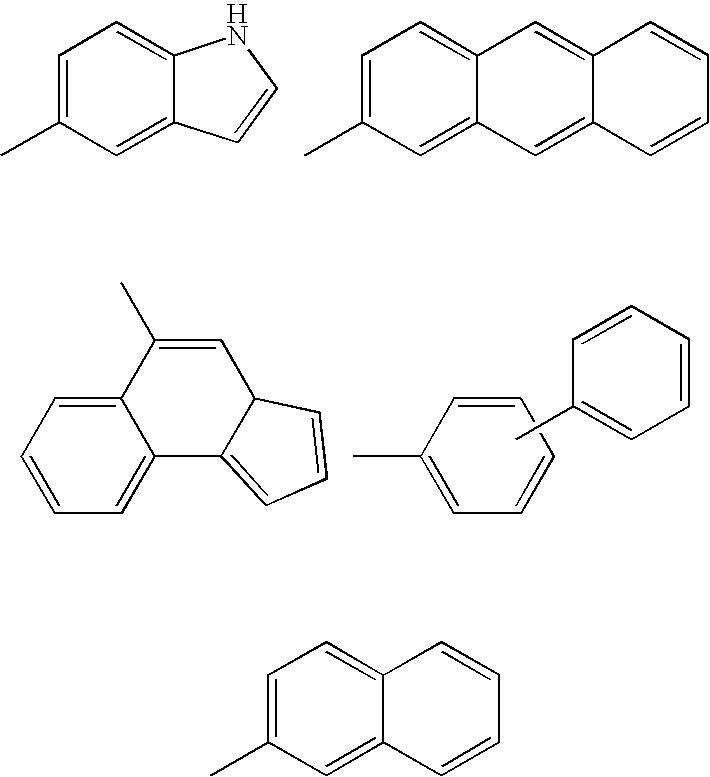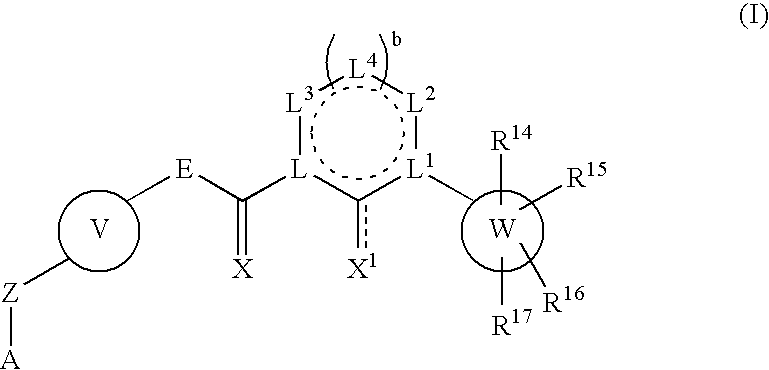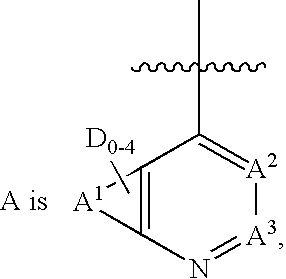Inhibitors of protein tyrosine kinase activity
a protein tyrosine kinase and inhibitor technology, applied in the field of compounds that inhibit the activity of protein tyrosine kinase, can solve the problems of limiting this approach and undermining the effect of vegf inhibitors as cancer therapeutics, and achieve the effects of enhancing the malignant behavior of cancer cells, promoting motility and invasion, and enhancing the invasion of certain cancer cells
- Summary
- Abstract
- Description
- Claims
- Application Information
AI Technical Summary
Benefits of technology
Problems solved by technology
Method used
Image
Examples
example 2
N-(4-(6,7-Dimethoxyquinolin-4-yloxy)-3-fluorophenyl)-2-oxo-3-phenylimidazolidine-1-carboxamide (9)
[0473] J To a solution of amine 6 (182 mg, 0.58 mmol) and iso-Pr2NEt (448 mg, 3.47 mmol) in dry DCM (7 ml) was added 2-oxo-3-phenylimidazolidine-1-carbonyl chloride (8) (Chem. Abstr.; 88; 6873 and P. Mayer, et al.; J. Med. Chem.; 2000, 43, 3653-3664) (260 mg, 1.16 mmol) and the reaction mixture was stirred at room temperature overnight. The reaction mixture was concentrated to dryness and the residue was partitioned between EtOAc and water. The organic phase was collected, dried over anhydrous Na2SO4 and filtered. The filtrate was concentrated under reduced pressure and the remaining solid was purified by column chromatography (eluent EtOAc) to afford title compound 9 as an off white solid (100 mg, 35% yield).
[0474]1H NMR (400 MHz, DMSO-d6) δ (ppm): 10.55 (s, 1H), 8.46 (d, J=5.28 Hz, 1H), 7.82 (m, 1H), 7.61 (d, J=7.8 Hz, 2H), 7.51 (s, 1H), 7.42 (m, 5H), 7.16 (t, J=7.24 Hz, 1H), 6.45 (...
example 3
N-(3-Fluoro-4-(7-methoxy-6-(3-morpholinopropoxy)quinolin-4-yloxy)phenyl)-3-(4-fluorophenyl)-2-oxoimidazolidine-1-carboxamide (15)
Step 1: 4-(3-(4-Chloro-7-methoxyquinolin-6-yloxy)propyl)morpholine (11)
[0476] To a solution of 4-chloro-7-methoxyquinolin-6-ol (10) (1.0 g, 4.77 mmol) (Patent application WO 98 / 13350) in DMF (20 ml) was added 4-(3-chloropropyl)morpholine (777 mg, 4.77 mmol) and K2CO3 (1.97 g, 14.31 mmol). The reaction mixture was heated to 50° C. for 6 hrs, concentrated to 50% of the original volume and partitioned between water and EtOAc. The organic phase was collected, washed with water (3×20 ml), dried over anhydrous Na2SO4, filtered and concentrated. The resultant solid was triturated with Et2O to give 11 as a white solid (1.1 g, 68% yield).
[0477]1H NMR (400 MHz, DMSO-d6) δ (ppm): 8.60 (d, J=4.70 Hz, 1H), 7.55 (d, J=4.70 Hz, 1H), 7.44 (s, 1H), 7.36 (s, 1H), 4.20 (t, J=6.46 Hz, 2H), 3.95 (s, 3H), 3.57 (t, J=4.70 Hz, 4H), 2.47 (m, 6H), 1.97 (m, 2H).
Step 2: 4-(3-(4-(...
example 4
N-(4-(6,7-dimethoxyquinazolin-4-ylamino)-3-fluorophenyl)-2-oxo-1-phenylpyrrolidine-3-carboxamide (27)
Step 1. N-(2-fluoro-4-nitrophenyl)-6,7-dimethoxyquinazolin-4-amine (41)
[0484] A stirred suspension of 4-chloro-6,7-dimethoxyquinazoline (40) (prepared according to A. J. Bridges et al., J. Med. Chem., 1996, 39, 267) (1.00 g, 4.45 mmol), 2-fluoro-4-nitroaniline (940 mg, 6.02 mmol) and cesium carbonate (3.20 g, 9.82 mmol) in anhydrous DMF (20 mL) was heated at 90° C. overnight under nitrogen. The reaction mixture was allowed to cool to room temperature. The reaction mixture was diluted with AcOEt, successively washed with water and a saturated solution of ammonium chloride, concentrated and triturated with AcOEt / hexanes. After filtration, the cake was adsorbed on silica gel and purified by flash column chromatography on (eluents MeOH / DCM: 2 / 98→10 / 90) to afford the title compound 41 (1.06 g, 69% yield) as a yellow-green solid. MS (m / z): 345.0 (M+H).
Step 2. N1-(6,7-dimethoxyquinazolin...
PUM
| Property | Measurement | Unit |
|---|---|---|
| enantiomeric excess | aaaaa | aaaaa |
| volume | aaaaa | aaaaa |
| temperature | aaaaa | aaaaa |
Abstract
Description
Claims
Application Information
 Login to View More
Login to View More - R&D
- Intellectual Property
- Life Sciences
- Materials
- Tech Scout
- Unparalleled Data Quality
- Higher Quality Content
- 60% Fewer Hallucinations
Browse by: Latest US Patents, China's latest patents, Technical Efficacy Thesaurus, Application Domain, Technology Topic, Popular Technical Reports.
© 2025 PatSnap. All rights reserved.Legal|Privacy policy|Modern Slavery Act Transparency Statement|Sitemap|About US| Contact US: help@patsnap.com



